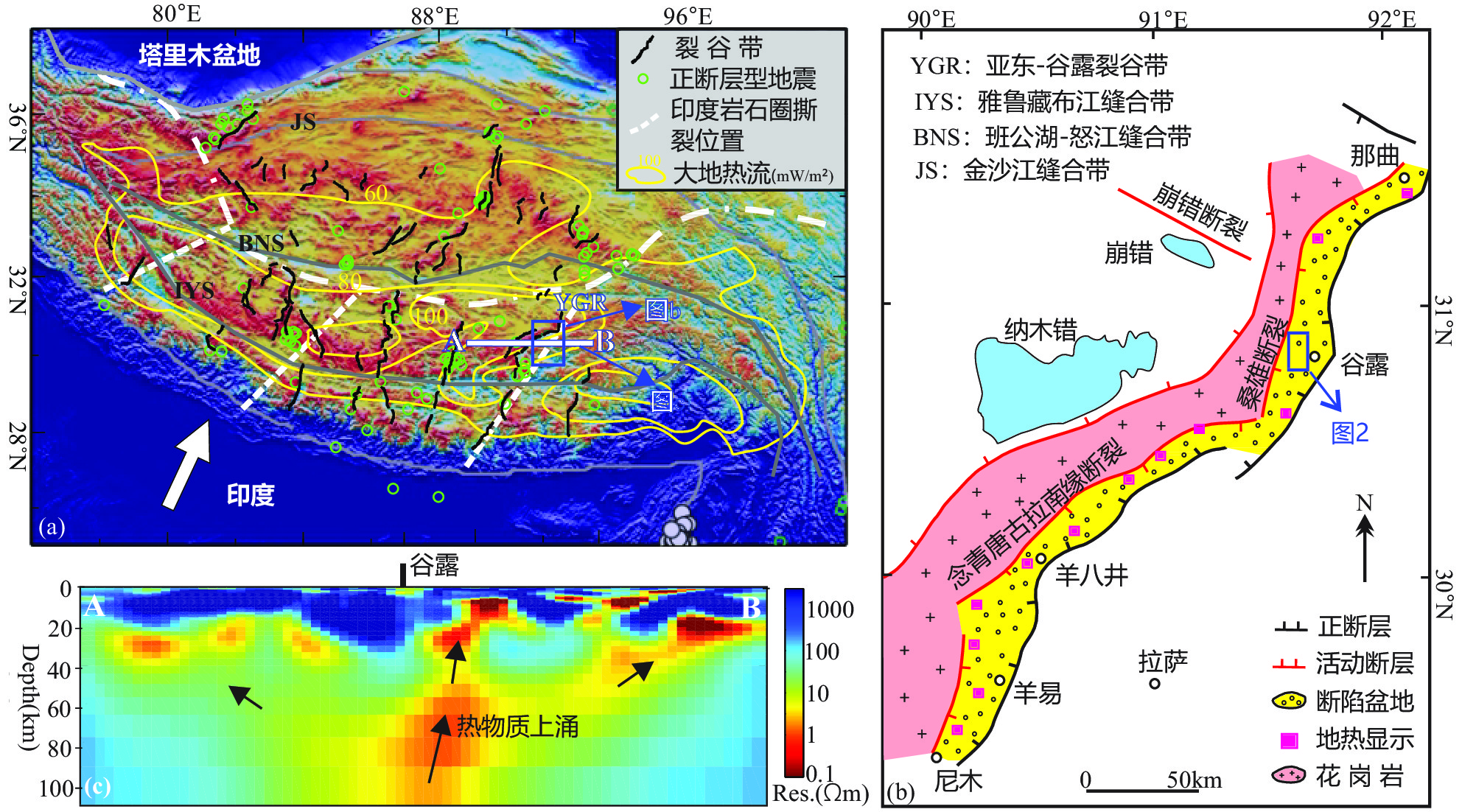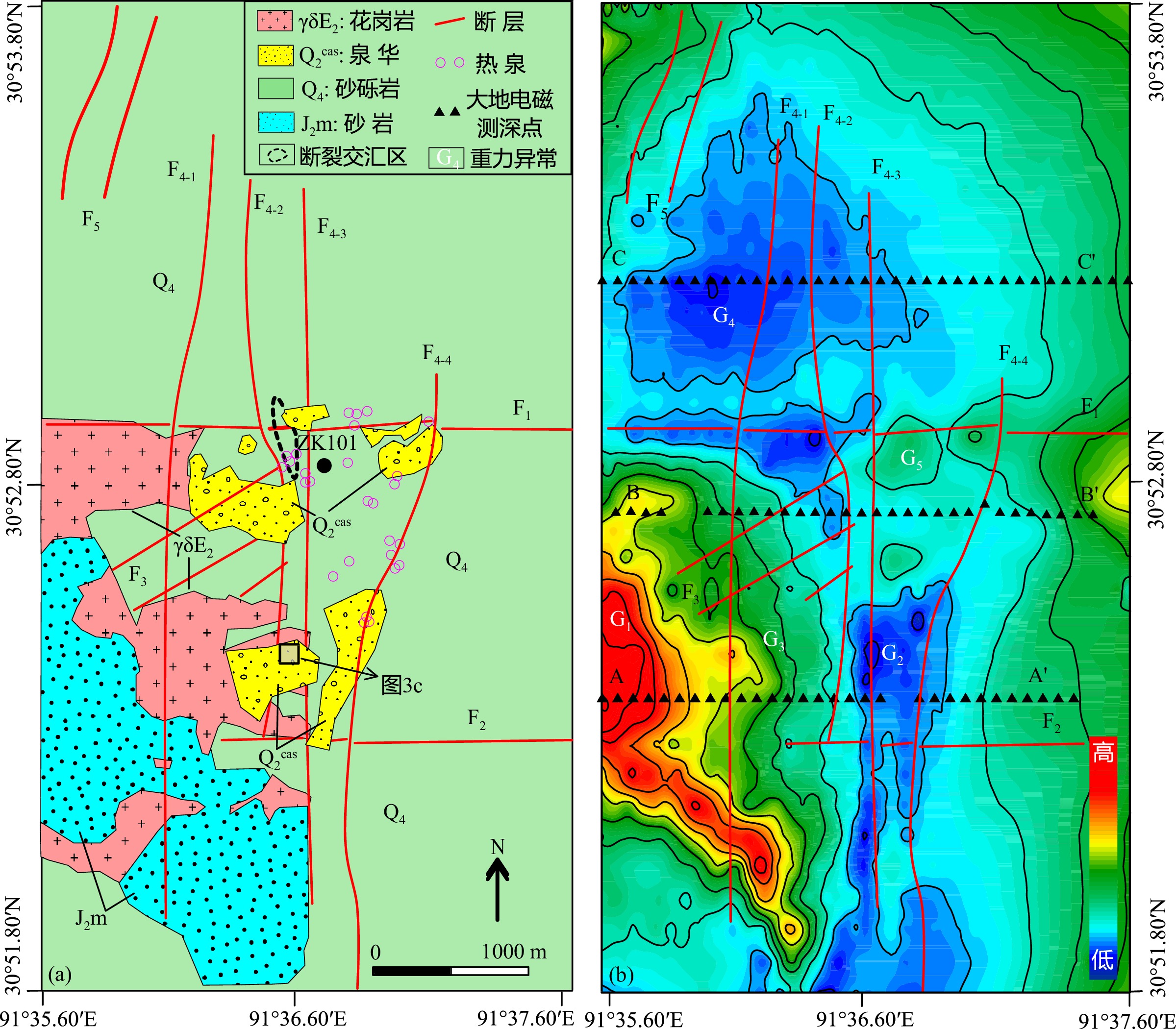The geothermal prospect and exploration direction of Gulu geothermal field in Xizang Plateau
-
摘要:
西藏亚东-谷露裂谷带是新生代的活动构造带,具有构造活跃、地震频繁、热泉广布、大地热流高等特征,孕育了丰富的地热资源。已实现商业开发多年的羊八井地热田和羊易地热田正是位于亚东-谷露裂谷带的中部,而位于该构造带北部的谷露地热田地热资源前景和勘探方向还有待深入认识。为此,本文解析了地表地热构造,对比了羊八井地热模式,分析了谷露地热田的深部热动力学背景,并结合钻井试采资料揭示谷露地热田具有良好的地热资源前景。在此基础上,利用大地电磁和重力预测了谷露地热田的地热分布具有南北分带性,即北部和中部具有深部和浅部两个层次的地热储层,而南部地热储层则以浅部为主。为深入研究亚东-谷露裂谷带的地热系统模式及指导地热勘探开发提供了重要的地球物理依据。
Abstract:The Yadong-Gulu rift in Xizang is an active tectonic zone in Cenozoic, characterized by active tectonics, frequent earthquakes, widespread hot springs and high heat flow, and has nurtured abundantly geothermal resources. The Yangbajing geothermal field and Yangyi geothermal field located in the central Yadong-Gulu rift have been commercially developed for decades, while the geothermal prospect and exploration direction in the Gulu geothermal field located in the northern Yadong-Gulu rift need to be furtherly clarified. Therefore, this paper analyzes the surface geothermal geology, discusses the Yangbajing geothermal model, and concludes that the Gulu geothermal field has a good geothermal prospect. The geothermal reservoirs revealed by magnetotelluric and gravity are characteristic of north-south zonation in the Gulu geothermal field. There are deep and shallow geothermal reservoirs in the north and middle of Gulu geothermal field, whereas the geothermal reservoirs in the south are mainly in shallow, which provides important geophysical basis for further understanding the geothermal model of the Yadong-Gulu rift and guiding geothermal exploration of Gulu geothermal filed.
-
Key words:
- Gulu geothermal filed /
- Geothermal prospect /
- Exploration direction /
- Magnetotelluric /
- Gravity
-

-
[1] Abiye T A, Haile T, 2008. Geophysical exploration of the Boku geothermal area, Central Ethiopian Rift[J]. Geothermics, 37: 586–596. doi: 10.1016/j.geothermics.2008.06.004
[2] Bian S, Gong J, Zuza A V, et al. , 2022. Along-strike variation in the initiation timing of the north-trending rifts in southern Xizang as revealed from the Yadong-Gulu rift[J]. Tectonics, 41, e2021TC007091.
[3] Chen Y, Li W, Yuan X, et al. , 2015. Tearing of the Indian lithospheric slab beneath southern Xizang revealed by SKS-wave splitting measurements[J]. Earth and Planetary Science Letters, 413: 13–24. doi: 10.1016/j.jpgl.2014.12.041
[4] Cumming W, 2009. Geothermal resource conceptual models using surface exploration data[C]. In: proceedings, 34th workshop on geothermal reservoir engineering, Stanford University, SGP−TR−187: 1 − 6.
[5] Deng Y, Tesauro M, 2016. Lithospheric strength variations in Mainland China: Tectonic implications[J], Tectonics, 35: 2313 − 2333.
[6] 多吉, 2014. 羊八井 世界屋脊上的“地热博物馆”[J]. 国土资源科普与文化, 1: 12-17
Dorji, 2014. "Geothermal Museum" on the Roof of the World in Yangbajing[J]. Science popularization and culture of land resources[J], 1: 12-17.
[7] 多吉, 2003. 典型高温地热系统--羊八井热田基本特征[J]. 中国工程科学, 5(1): 42-47 doi: 10.3969/j.issn.1009-1742.2003.01.008
Dorji, 2003. The basic characteristics of the Yangbajing geothermal field-A typical high-temperature geothermal system[J]. China engineering science, 5(1): 42-47. doi: 10.3969/j.issn.1009-1742.2003.01.008
[8] Furlong K P, Chapman D S, 1987. Thermal state of the lithosphere[J]. Reviews of Geophysics, 25(6): 1255-1264. doi: 10.1029/RG025i006p01255
[9] 高洪雷, 胡志华, 万汉平, 等, 2023. 西藏谷露地热田地热地质特征[J]. 地球科学, 48(3): 1014 − 1029.
Gao H, Hu Z, Wan H, et al., 2022. characteristics of geothermal geology of the Gulu geothermal field in Xizang[J]. Earth Science, 48(3): 1014 − 1029.
[10] 郭镜, 夏时斌, 2022. 川东褶皱带地热系统的空间载体——相互连通的断裂系统: 以四川广安牟家镇地热井为例[J]. 沉积与特提斯地质, 42(4): 642 − 652.
Guo J, Xia S B, 2022. Spatial carrier of geothermal system in eastern Sichuan fold zone—interconnected fault system: A case study of geothermal well Moujia Town, Guangan, Sichuan[J]. Sedimentary Geology and Tethyan Geology, 42(2): 642 − 652.
[11] 郭镜, 唐发伟, 官辉, 等, 2022. 青藏高原如角高温地热系统构造−热耦合成热模式[J/OL]. 中国地质, https://kns.cnki.net/kcms/detail/11.1167.P.20220919.1606.002.html.
Guo J, Tang F W, Guan H, et al. , 2022. The structure−thermal coupling model of the high temperature geothermal system in Rujiao on the Xizang Plateau[J/OL]. Geology in China, https://kns.cnki.net/kcms/detail/11.1167.P.20220919.1606.002.html.
[12] Guo Q H, Wang Y, Wei L, 2007. Major hydrogeochemical processes in the two reservoirs of the Yangbajing geothermal field, Xizang, China[J]. Journal of Volcanology & Geothermal Research, 166(3-4): 255-268.
[13] 侯增谦, 莫宣学, 高永丰, 等, 2006. 印度大陆与亚洲大陆早期碰撞过程与动力学模型: 来自西藏冈底斯新生代火成岩证据[J]. 地质学报, 80(9): 1233-1248 doi: 10.3321/j.issn:0001-5717.2006.09.001
Hou Z Q, Mo X X, Gao Y F, et al. , 2006. Early Processes and Tectonic Model for the Indian—Asian Continental Collision: Evidence from the Cenozoic Gangdese Igneous Rocks in Xizang[J]. Acta Geologica Sinica, 80(9): 1233-1248. doi: 10.3321/j.issn:0001-5717.2006.09.001
[14] Hu S B, He L, Wang J, 2000. Heat flow in the continental area of China: a new data set[J]. Earth & Planetary Science Letters, 179(2): 407-419.
[15] 胡志华, 高洪雷, 万汉平, 等, 2022. 西藏羊八井地热田水热蚀变的时空演化特征[J]. 地质论评, 68(1): 359-374 doi: 10.16509/j.georeview.2021.12.105
Hu Z H, Gao H L, Wan H P, 2022. Temporal and spatial evolution of hydrothermal alteration in the Yangbajing Geothermal Field, Xizang(Xizang)[J]. Geological Review, 68(1): 359-374. doi: 10.16509/j.georeview.2021.12.105
[16] 姜光政, 高堋, 饶松, 等, 2016. 中国大陆地区大地热流数据汇编(第四版)[J]. 地球物理学报, 59(8): 2892-2910 doi: 10.6038/cjg20160815
Jiang G Z, Gao P, Rao S, et al. , 2016. Compilation of heat flow data in the continental area of China (4th edition)[J]. Chinese Journal of Geophysics (in Chinese), 59(8): 2892-2910. doi: 10.6038/cjg20160815
[17] James R, 1975. Rapid estimation of electric power potential of discharging geothermal Wells[J]. 176(26): 7 − 11.
[18] Li J T, Song X D, 2018. Tearing of Indian mantle lithosphere from highresolution seismic images and its implications for lithosphere coupling in southern Xizang[J]. Proceedings of the National Academy of Sciences of the United States of America, 115(33): 8296-8300. doi: 10.1073/pnas.1717258115
[19] 刘静, 申旭辉, 孟恺, 等, 2009. 谷露盆地西缘断裂晚第四纪活动初步研究[J]. 地震, 29(3): 45-53 doi: 10.3969/j.issn.1000-3274.2009.03.006
Liu J, Shen X H, Meng K, 2009. Preliminary study on late Quaternary activity of faults in the western margin of Gulu Basin[J]. Earthquake, 29(3): 45-53. doi: 10.3969/j.issn.1000-3274.2009.03.006
[20] 刘昭, 蔺文静, 张萌, 等, 2014. 西藏尼木—那曲地热流体成因及幔源流体贡献[J]. 地学前缘, 21(6): 356-371 doi: 10.13745/j.esf.2014.06.034
Liu Z, Lin W, Zhang M, et al. , 2014. Origin of geothermal fluid and contribution of mantle source in Nimu-Nagqu, Xizang[J]. Earth Science Frontiers, 21(6): 356-371. doi: 10.13745/j.esf.2014.06.034
[21] Majorowicz J and Grasby S, 2010. Heat flow, depth–temperature variations and stored thermal energy for enhanced geothermal systems in Canada[J]. Journal of Geophysical Engineering, 7(3): 232-241. doi: 10.1088/1742-2132/7/3/002
[22] 莫宣学, 2010. 青藏高原地质研究的回顾与展望[J]. 中国地质, 37(4): 841-853 doi: 10.3969/j.issn.1000-3657.2010.04.002
Mo X X, 2010. A review and prospect of geological researches on the Qinghai-Xizang Plateau[J]. Geology in China, 37(4): 841-853. doi: 10.3969/j.issn.1000-3657.2010.04.002
[23] Newman G, Gasperikova E, Hoversten G, et al., 2008. Three−dimensional magnetotelluric characterization of the Coso geothermal field. Geothermics, 37: 369 − 399.
[24] 潘桂棠, 王立全, 耿全如, 等, 2020. 班公湖—双湖—怒江—昌宁—孟连对接带时空结构——特提斯大洋地质及演化问题[J]. 沉积与特提斯地质, 40(3): 1 − 19
Pan G T, Wang L Q, Geng Q R, et al., 2020. Space−time structure of the Bangonghu−Shuanghu−Nujiang−Changning−Menglian Mega−suture zone: A discussion on geology and evolution of the Tethys Ocean. Sedimentary Geology and Tethyan Geology, 40(3): 1 − 19.
[25] Peacock J R, Thiel S, Reid P, et al., 2012. Magnetotelluric monitoring of a fluid injection: Example from an enhanced geothermal system[J]. Geophysical Research Letters, 39(L18403) : 1 − 5.
[26] 秦进生, 2003. 西藏羊易地热田的水热蚀变及地热地质意义[J]. 太原理工大学学报, 34(2): 161-165 doi: 10.3969/j.issn.1007-9432.2003.02.017
Qin J S, 2003. Hydrothermal alteration and evalution in Yangyi geothermal field[J]. Journal of Taiyuan University of Technology, 34(2): 161-165. doi: 10.3969/j.issn.1007-9432.2003.02.017
[27] Rodi W, Mackie R L, 2001. Nonlinear conjugate gradients algorithm for 2−D magnetotelluric inversion[J]. Geophysics, 66, 174 − 187.
[28] 沈敏子, 1992. 羊八井水热系统的演变和热田模式[C]// 中国西藏高温地热开发利用国际研讨会论文选, 95 − 98
Shen M, 1992. Evolution and model of Yangbajing hydrothermal system[C]// International Symposium on High Temperature Geothermal Development and Utilization in Xizang, China, 95 − 98.
[29] Spycher N, Peiffer L, Sonnenthal G L, et al. , 2014. Integrated multicomponent solute geothermometry[J]. Geothermics, 51: 113-123. doi: 10.1016/j.geothermics.2013.10.012
[30] Tao W, Shen Z K, 2008. Heat flow distribution in Chinese continent and its adjacent areas[J]. Progress in Natural Science, 18: 843 − 846.
[31] Tapponnier P. , Xu Z Q, Roger F, et al. , 2001. Oblique Stepwise Rise and Growth of the Xizang Plateau [J]. Science, 294: 1671-1677. doi: 10.1126/science.105978
[32] 佟伟, 章铭陶, 张知非, 等, 1981. 西藏地热[M]. 北京: 科学出版社, 1 − 128
Tong W, Zhang T M, Zhang Z F, et al. , 1981. Geotherm in Xizang[M], Beijing: Science press, 1 − 128.
[33] 王桥, 杨剑, 唐发伟, 等, 2023. 碳酸盐岩深覆盖区隐伏岩溶构造的音频大地电磁测深探测—以云南大关地区为例[J]. 沉积与特提斯地质. https://doi.org/10.19826/j.cnki.1009−3850.2021.08002.
Wang Q, Yang J, Tang F W, et al., 2021. Audio magnetotelluric detection of hidden karst in deep carbonate coverage area: A case study of Daguan area in Yunnan province, China[J]. Sedimentary Geology and Tethyan Geology, https://doi.org/10.19826/j.cnki.1009−3850.2021.08002.
[34] 王鹏, 陈晓宏, 沈立成, 等, 2016. 西藏地热异常区热储温度及其地质环境效应[J]. 中国地质, 43(4): 1429-1438
Wang P, Chen X H, Shen L C, et al. , 2016. Reservoir temperature of geothermal anomaly area and its environmental effect in Xizang[J]. Geology in China, 43(4): 1429-1438.
[35] Wang G, Wei W B, Ye G F, et al. , 2017. 3-D electrical structure across the Yadong-Gulu rift revealed by magnetotelluric data: New insights on the extension of the upper crust and the geometry of the underthrusting Indian lithospheric slab in southern Xizang[J]. Earth and Planetary Science Letters, 474: 172–179. doi: 10.1016/j.jpgl.2017.06.027
[36] Wang S, Chevalier M L, Pan J, et al. , 2020. Late Quaternary activity of the southern Yadong-Gulu rift, southern Xizang[J]. Tectonophysics, 790, 228545.
[37] Wu C D, Nelson K D, Wortman G, et al. , 1998. Yadong cross structure and South Xizang Detachment in the east central Himalaya (89°–90°E) [J]. Tectonics, 17(1): 28–45. doi: 10.1029/97TC03386
[38] Wu C L, Tian X B, Xu T, et al. , 2019. Deformation of crust and upper mantle in central Xizang caused by the northward subduction and slab tearing of the Indian lithosphere: New evidence based on shear wave splitting measurements[J]. Earth and Planetary Science Letters, 514: 75–83. doi: 10.1016/j.jpgl.2019.02.037
[39] 吴中海, 赵希涛, 吴珍汉, 等, 2006. 西藏当雄—羊八井盆地的第四纪地质与断裂活动研究[J]. 地质力学学报, 12(3): 305 − 315.
Wu Z, Zhao X, Wu Z, et al., 2006. Quaternary geology and faulting in the Damxung-Yangbajain basin, southern Xizang[J]. Journal of Geomechanics, 12(3): 3005 − 315.
[40] Wright P M, Ward S H, Ross H P, et al. , 1985. State of the art geophysical exploration for geothermal resources[J]. Geophysics, 50: 2666–2696. doi: 10.1190/1.1441889
[41] Yin A, Harrison T, 2000. Geologic evolution of the Himalayan‐Xizang orogen[J]. Annual Review of Earth and Planetary Sciences, 28: 211–280. doi: 10.1146/annurev.earth.28.1.211
[42] 张萌, 蔺文静, 刘昭, 等, 2014. 西藏谷露高温地热系统水文地球化学特征及成因模式. 成都理工大学学报(自然科学版)[J], 41(3): 382 − 392
Zhang M, Lin W, Liu Z, et al., 2014. Hydrogeochemical characteristics and genetic model of Gulu high−temperature geothermal system in Xizang[J]. Journal of Chengdu University of Technology (Science and Technology Edition), 41(3): 382 − 392.
[43] 赵平, 谢鄂军, 多吉, 等, 2002. 西藏地热气体的地球化学特征及其地质意义[J]. 岩石学报, 18 (4): 539-550 doi: 10.3969/j.issn.1000-0569.2002.04.013
Zhao P, Xie E J, Dorji. Et al. , 2002. Geochemical characteristics and geological significance of geothermal gases in Xizang[J]. Acta Petrology. Sinica, 18 (4): 539-550. doi: 10.3969/j.issn.1000-0569.2002.04.013
[44] 赵文津, 江万, 吴珍汉, 等, 2003. 西藏羊八井深部构造-地震-地热关系及机理调查研究[J]. 中国地质科学院, 95-97
Zhao W J, Jiang W, Wu Z H, et al. , 2003. Investigation and mechanism of tectonic-seismic-geothermal relationship in deep Yangbajing, Xizang Province [J]. Chinese Academy of Geological Sciences, 95-97.
[45] 赵元艺, 赵希涛, 马志邦, 等, 2010. 西藏谷露热泉型铯矿床年代学及意义[J]. 地质学报, 84(2): 211-220 doi: 10.19762/j.cnki.dizhixuebao.2010.02.007
Zhao Y Y, Zhao X T, Ma Z B, et al. , 2010. Chronology and significance of Gulu geothermal spring type cesium deposit in Xizang Province[J]. Acta Geologica. Sinica, 84(2): 211-220. doi: 10.19762/j.cnki.dizhixuebao.2010.02.007
[46] 郑克棪, 郑帆, 2020. 中国地热发电产业前景探讨[J]. 中外能源, 25(11): 17-23
Zheng K Y, Zheng F, 2020. Discussion on the prospect of geothermal power industry in China[J]. China and Foreign Energy, 25(11): 17-23.
-




 下载:
下载:






